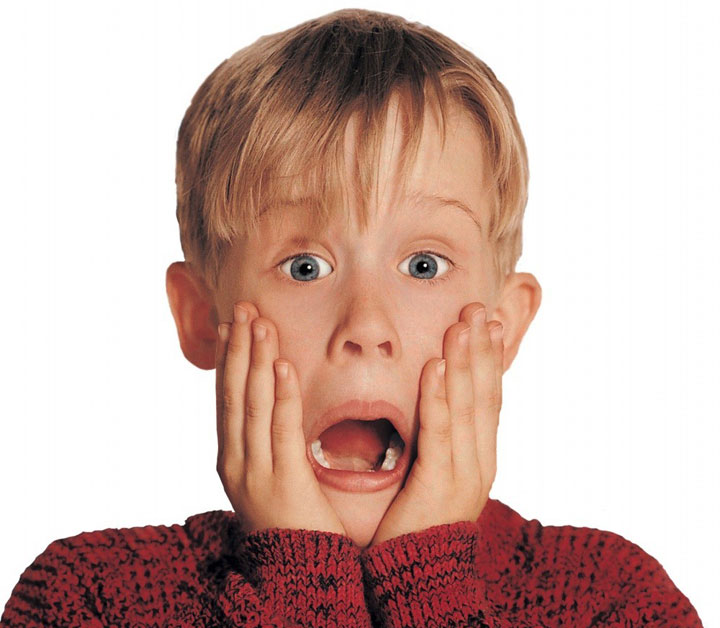Home Alone has become as much a part of Christmas as It’s a Wonderful Life.

The 1990 feature made Macaulay Culkin a household name and was No. 1 at the box office for an incredible 12 straight weeks. It topped $285 million in domestic box office back when a movie ticket went for half what it costs today. It is listed in the Guinness World Records as the highest-grossing live-action comedy of all time.
Nearly a quarter-century later, everyone is familiar with the premise of the film: eight-year-old Kevin McCallister (Culkin) is accidentally left alone over Christmas when his parents (Catherine O’Hara and John Heard) and siblings sleep in and then race to the airport for a trip to Paris. Two dim-witted burglars (Joe Pesci and Daniel Stern) try to break into his house, but the lad outsmarts them with various booby traps and hilarity ensues.
The film almost didn’t get made. Warner Bros pulled out at the last minute and 20th Century Fox stepped in, boosting the modest budget by a few million dollars. Executive producer John Hughes was said to have penned the script in two weeks after being charmed by Culkin while directing Uncle Buck.
“He loved this boy and he just cranked out the script,” says Julio Macat, the cinematographer on Home Alone. Macat went on to shoot five Hughes productions and is currently shooting Daddy’s Home with Will Ferrell and Mark Wahlberg in New Orleans.
“I’ve done 36 films,” says Macat, “and this is still by far my favourite.”
Home Alone was Macat’s first film as a cinematographer. He was teamed with a young director then just making a name for himself, Chris Columbus, who went on to shoot Only the Lonely with Macat as well as helm the first two Harry Potter films.
BELOW: Watch the trailer for Home Alone.
Columbus had seen some Christmas commercials Macat had shot for McDonald’s as well as some second unit work. “We hit it off and I knew this was my chance,” says Macat. “One of my motivators was fear — I thought every day they were going to figure out I don’t know what I’m doing.”
Instead, Macat contributed significantly to the look of the film. He says he and Columbus drew inspiration from A Christmas Story, a holiday favourite made by Canadian director Bob Clark. “It was the story of a little kid. Everything was centred around him and he wanted his rifle and stuff — that was kind of the flavour.”
To that end, Macat suggested pitching his camera lower than usual, shooting many scenes at wide angles to see this world from Culkin’s perspective. “We really got into the mind of a young kid.”
READ MORE: 12 fun facts about Christmas Vacation 25 years after its release
Macat also had great luck with a small, ground-level camera he nicknamed the “bonus cam.”
“We’d put it in a spot and Joe Pesci would plop right in front of it. By accident we started seeing that the bonus cam was getting the funniest moments.”
Macat remembers Culkin as “this phenom, so mature and cute.” He has warm memories of the entire cast, singling out Toronto-born O’Hara. “She was wonderful and an amazing comedic actress.” John Candy had a key cameo in the film, giving O’Hara’s frantic mother character a lift through the snow from an out-of-town airport. “We only had one or two days with him,” says Macat. “That was a great cameo for the movie.”
Computer-generated effects cost around $10,000 a pop back then, Macat figures, forcing the production team to come up with some old-fashioned — and cheaper — mechanical solutions. Just as Culkin’s Kevin would jerry-rig turntables and cut-outs to make it look as if adults were in the house, Macat was cutting into Christmas ornaments, adding mirrors and creating effects in the camera.
A scene where it looked like Pesci’s head was on fire was shot by placing a mirror in front of a camera lens reflecting a wig stand wrapped in black. The wig stand image was matched through the lens with a shot of the contours of Pesci’s head. The two images were combined in the camera and the wig stand was set on fire. Says Macat, “We shot old-fashioned tricks that I’m pretty proud of still.”
Macat also credits the stunt team with dodging paint cans and everything else thrown at them. “They were fearless, doing all these pratfalls, guiding the camera to the spot that was funny.” When heavy objects came at Pesci and Stern head on, the audience, says Macat, was completely in on the gag.
Macat credits production designer John Muto for the Christmas-y look of the film, which was shot in Winnetka, Ill., near Chicago. “The area where we shot was just picture perfect and the snow (some real, some trucked in) really helped a lot,” he says.
A favourite shot was when Kevin walks into the church. “We just lit the street so beautifully,” says Macat. “We were just inspired.”
Reds and other colours throughout the film were tweaked to help convey Kevin’s heightened anxiety about being home alone. Add a score by John Williams, says Macat, and you almost can’t help making a Christmas classic.
There’s another reason the film is so loved by kids today.
“It’s because it’s really empowering,” says Macat. “The concept that a young kid could overcome his fear and defend his home … what kid wouldn’t love watching that happen?”



Comments